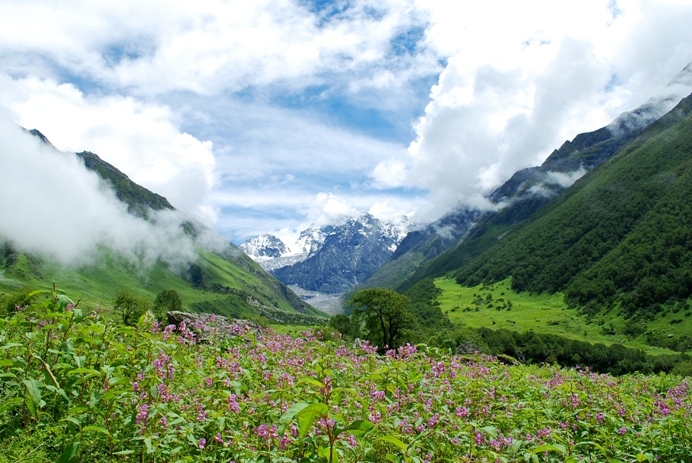

One of India’s most coveted National Natural parks, the Valley of Flowers in Uttarkhand, was unknown to the outside world until its glories were unveiled in a book called ‘The Valley of Flowers’ by Mr. Frank S. Smith – mountaineer, explorer, botanist, in 1937. The book describes the beauty and floral splendours of the valley and throws open the doors of this verdant jewel to nature enthusiasts all over the world.
The Valley of Flowers, an irresistible wonder for nature lovers, botanist’s, ecologists, ornithologists and trekkers is an alpine valley formed by the retreating glaciers which, over the years, became host to numerous plants that adapted to the harsh climatic conditions prevailing there.
Bordered on either side by majestic peaks, many capped with snow, the valley is cut midway by the River Pushpawati which emerges from the glacial deposits around the Rataban andNilgiri Ranges, cuts through the Valley. The major portion of the valley is on its right bank and is a paradise for trekkers. The trek towards the valley starts from Govindghat, after crossing the Alaknanda River on a hanging bridge on the way to Badrinath. The main valley is home to many smaller valleys carved out by streams of melting glaciers. The banks of these valleys are a mosaic of different varieties of flowers. One of the most well-known of these valleys is located along the Donagair Garh, the last of many streams. Subtle fragrances fill the air from the many magnificent flowering plants that dot the banks. Govidkhat, Gangaharia, Hemkund Sahib, Valley of Flowers, Badrinath, Rishikesh are some of the popular trekking routes here, which promise scenery replete with sparkling hill streams, rivers, butterflies, birds, Himalayan bear, leopards and musk deer.
The Valley of Flowers is in full bloom during June to August and it remains snow covered from November to May. Head for the valley during the flowering season to witness a veritable feast for the eyes – more than 300 species of rare wild flowers. Some of the beauties include the Arum or Arisaema costatum with a head resembling that of a cobra, the Nomochera Oxypetala which resembles the full blown sun, the Brahma Kamal or Saussurea Obvallata, a graceful creamish flower, the blue poppy, etc. Some flowering plant species having tremendous medicinal values include Anemone, Geranium, Marsh, Marigold, Primula, Potentilla, Geum, Aster. Lilium, Himalayanblue poppy, Aconite, Delphinium, etc. The valley’s pinkish glow can be attributed to large colonies of Androsace. Yellow flowers dot the valley as July proceeds… The nearest airport is Jolly Grant, 306 km away and the nearest railhead is Rishikesh at a distance of 289 kms. The valley is 18 km from Govindghat and 19km from Badrinath.
